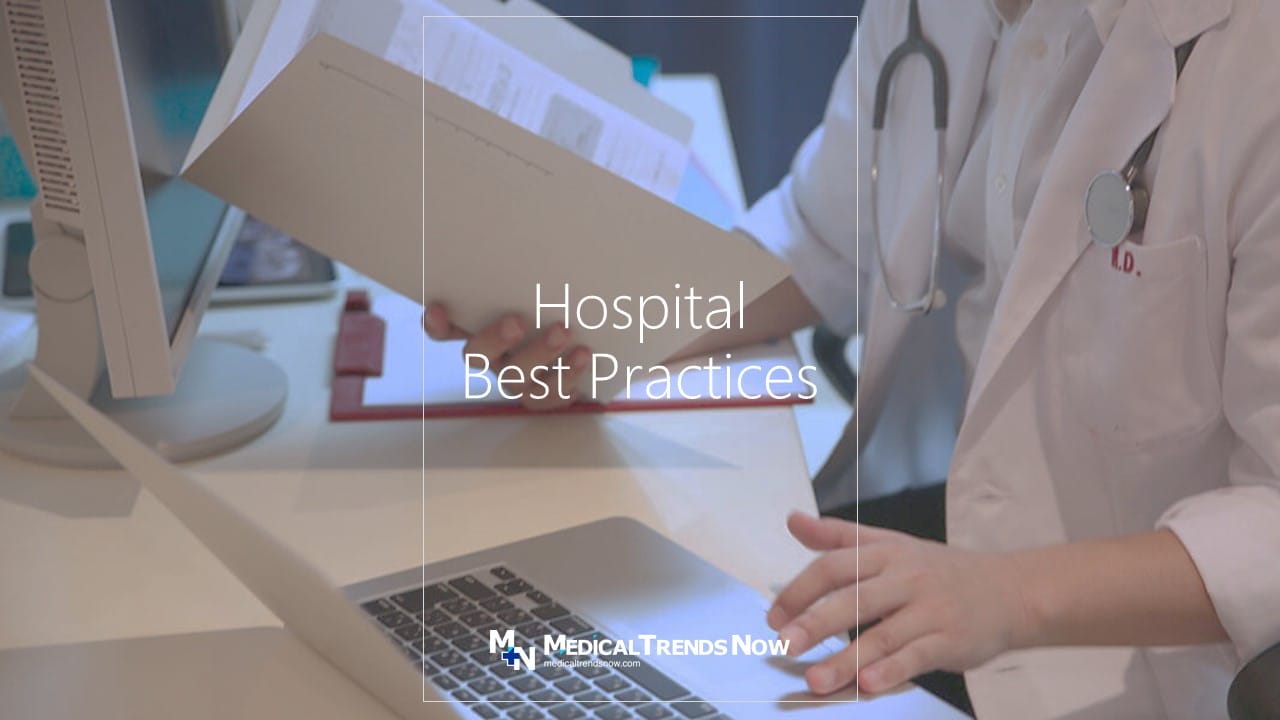Table of Contents
Hospital management is a process used to ensure that the hospital runs efficiently and effectively. By following the best practices for hospital managers, directors, and stakeholders, medical centers and general hospitals can improve their operations and patient care.
According to the recent Harvard Business School research, there is an excellent correlation between management practices and patient care. The study found that:
- Hospitals with more effective management practices provided higher-quality care.
- Higher-rated hospital boards had a superior performance by hospital management staff.
- Hospitals with boards that paid greater attention to clinical quality had a management that better monitored quality performance.
- Hospitals with boards that used clinical quality metrics more effectively had a higher performance by hospital management staff on target setting and operations.
Understanding the best practices in hospital management is essential for a number of reasons.
- First, it can help hospitals save money;
- Second, it can help hospitals provide better patient care;
- Finally, it can help hospitals maintain compliance with regulatory requirements.
Medical centers and general hospitals are safe havens for people with illnesses and a place of tranquility and care for patients. However, like any other business, medical hospitals, health laboratories, pharmacies, nursing homes, psychiatric facilities, and other infirmary centers must operate efficiently to maintain their reputation and remain financially viable.
Here are 16 best practices for hospital management (2022):
Tip 1: Establish Clear Leadership and Accountability
One of the best ways to improve hospital management is to establish clear leadership and accountability. Leaders should be able to clearly articulate their goals and strategies and be held accountable for achieving them. They should also be able to provide clear instructions to subordinates and be responsive to feedback. In addition, leaders should create a culture of accountability. Medical technologists, pharmacists, radiologists, nurses, doctors, and other medical staff are encouraged to challenge one another and take ownership of their work. By implementing these best practices, healthcare facilities can improve their management skills and increase efficiency.
Effective hospital management by establishing clear leadership and accountability can be difficult in large, complex organizations. But it is essential to ensure that the management efficiently and effectively follows decisions. Leaders must have the authority to make decisions and be accountable for their actions, while medical staff needs to know who to turn to when they have questions or concerns. Clear communication between leaders and medical staff is also crucial so that everyone understands each of their tasks and overall goals.
Tip 2: Implement a Systematic Approach to Decision Making
Dental clinics, medical centers, and general hospitals need a systematic approach to make sound decisions. A systematic approach involves breaking down a complex problem into smaller, easier-to-handle pieces. By doing this, government hospitals, community health centers, and treatment centers can identify all the possible solutions and weigh each option carefully before making a decision. This method is frequently more effective than making decisions based on intuition or personal opinion.
A systematic approach to healthcare operations optimization is critical to ensuring patients’ highest quality of care. Using knowledge management tools, medical hospitals, health laboratories, pharmacies, nursing homes, psychiatric facilities, and other infirmary centers can create and maintain a comprehensive database of patient information, including medical history and current health status. This information can provide medical professionals with well-informed decisions about patient care and improve efficiency and effectiveness across the entire healthcare system.
Tip 3: Use Data to Improve Patient Care
In the current healthcare system, data is a valuable resource that can significantly improve overall patient care, diagnostics, treatment, and therapy. However, medical hospitals, health laboratories, pharmacies, nursing homes, psychiatric facilities, and other infirmary centers are not using data effectively to improve patient care. One reason for this is that nurses, doctors, and managers often lack the resources necessary to collect and use data effectively. Additionally, government and private hospitals do not have a clear strategy for using data to improve patient care.
Healthcare facilities could benefit from adopting a data-driven approach to patient care if they have the resources and infrastructure necessary to do so. A data-driven approach involves using data to identify patterns and trends in patient care given by medical technologists, radiologic technologists, nurses, doctors, and other medical staff. This information can then be used to make changes in patients’ treatments. By using data in this way, dental clinics, medical centers, and general hospitals can improve the quality of patient care and save money.
However, several clinics, medical centers, and general hospitals are not using data effectively to improve patient care. One reason for this is that nurses, doctors, and managers often lack the resources necessary to collect and use data effectively. Additionally, several healthcare facilities do not have a clear strategy for using data to improve patient care. However, by using data in a data-driven approach, children’s hospitals, drug stores, clinical laboratories, and even wellness centers can enhance the quality of patient care and save money.
Tip 4: Promote from Within
Several clinics, medical centers, and general hospitals are promoting from within their staff to improve the quality of patient care. The premise is “Happy staff means happy patients.” Your pharmacists, medical technologists, radiologic technologists, nurses, doctors, and other medical staff will be more likely to take pride in their work if they feel there is an opportunity for promotion.
Several management gurus believe that promoting from within will create a more engaged and motivated workforce, resulting in better performance. However, there are some factors to consider before implementing a promotion from within policy. First, it is vital to ensure that the medical professional candidates are qualified for the position. Second, it is vital to create a promotion from within the program that rewards medical staff for their hard work and dedication. Finally, it is essential to provide health care workers with training on how to be successful in their new roles.
To promote from within, government hospitals, community health centers, and treatment centers should make it easy for new medical workers to learn and grow their careers. They should also provide opportunities for healthcare workers to develop their skills and knowledge and give them the support they need to achieve their goals. Finally, medical hospitals, health laboratories, pharmacies, nursing homes, psychiatric facilities, and other infirmary centers should create a culture that is supportive of innovation and change.
Tip 5: Create a Culture of Engagement
One of the most important aspects of hospital management is creating a culture of engagement. This means engaging with patients, healthcare professionals, and their families to develop a sense of community and support. It also means being open and transparent with information, policies, and procedures. By doing this, various healthcare facilities can create a safe and supportive environment for everyone involved.
A culture of engagement is vital in any organization, especially in a hospital. Various dental clinics, medical centers, and general hospitals are often places where people are injured or ill. It is essential that the hospital staff feel engaged and invested in their patients’ care. This can be accomplished by creating a culture that values engagement and encourages medical technologists, radiologic technicians, nurses, doctors, and other medical staff to participate in their patients’ care.
Management Tip 6: Invest in Technology Solutions
Healthcare is an ever-growing industry, and with that comes the need for a health care facility to keep up with the latest technology solutions. Various clinics, medical centers, and general hospitals invest in technology solutions such as electronic medical records (EMRs), patient information systems (PIS), and hospital automation to stay ahead of the curve. EMRs allow various health care facilities to track patient data in a centralized location, which can help improve care coordination and optimize resources. PISs provide patients and their families with access to their health records, which can help them make informed decisions about their care. Hospital automation can support children’s hospitals, drug stores, clinical laboratories, and even wellness centers to save time and money by automating routine tasks such as billing and inventory management. By investing in these technology solutions, medical hospitals, health laboratories, pharmacies, nursing homes, psychiatric facilities, and other infirmary centers can ensure that they are providing quality care.
Health clinics, medical centers, and general hospitals are always looking for ways to save money and improve efficiency. One way to do this is to invest in technology solutions like virtual reality, automation, and robotics. These technologies can help government hospitals, community health centers, and treatment centers reduce costs, increase efficiency, and improve patient care. Hospital management automation is essential because it can help medical hospitals, health laboratories, pharmacies, nursing homes, psychiatric facilities, and other infirmary centers be more effective and efficient.
Automation (internet of medical things) can reduce the number of hours that medical technologists, radiologic technicians, nurses, doctors, and other medical staff need to be on-site. On the other hand, robotics can help general and children’s hospitals to improve the accuracy and speed of medical procedures.
Management Tip 7: Support Medical Staff Development
Medical staff development is key to ensuring that hospital medical technologists, pharmacists, radiologic technologists, nurses, doctors, and other medical staff can provide high-quality patient care. Various medical centers, general hospitals, and dental clinics have implemented programs to support medical staff development for nurses, medical assistants, residents, and even doctors. But it is crucial to ensure that these programs are effective across the board. Medical management should factor in when designing a medical staff development program, including the needs of the hospital and its patients, the availability of resources, and the personnel involved.
Medical staff development is an essential aspect of hospital management. It helps to ensure that the medical staff is up-to-date on the latest techniques and practices and that they can provide quality care to patients. It can also help to reduce the incidence of medical errors.
Hospital support staff are essential to the success of any hospital. They provide vital services such as cleaning, laundry, food service, and patient care. To ensure that these medical workers can provide the best possible service to patients and staff, they must receive regular training and development.
Management Tip 8: Curate Quality Content (Social Media, Blogs & Website)
To improve the hospital’s new patients and retain existing patients, hospital management and the marketing department must create a robust digital marketing communication strategy. It is vital to curate quality content for your blogs and website that potential patients will read online. This means making informative and engaging content so that readers will stay interested in reading your posts. Additionally, you can help attract new patients and retain current ones by creating compelling content. By following these best practices when writing about hospital management, you can ensure that your content is valuable and informative.
Quality content is vital for any website or blog because it helps you rank on the first page on Google search. Ensuring that your content is high quality will help you attract and retain readers, improve SEO, increase backlinks, and increase the chances of converting them into customers. There are a few things that you can do to ensure that your content is of the highest quality.
First, make sure that your content is fresh and original. If it is published elsewhere before being posted on your website or blog, ensure to cite the source material. This will help ensure that you’re not plagiarizing other people’s work. It will also show your readers that you’re taking the time to research and write about topics interestingly and engagingly.
Second, make sure that your content is well-researched. Do your research before writing if you’re writing about a topic that you don’t know much about. This will help ensure that your content is accurate and unbiased. Finally, make sure that your content is easy to read and navigate. Make use of clear and concise language and effective formatting techniques such as headings and lists. This will help your readers find the information they’re looking for quickly, and it will also make the content more engaging.
Management Tip 9: Engage with the Community
It is important for medical centers, general hospitals, and health clinics to engage with the community to improve patient care. Hospital staff should be familiar with the local community and its history to understand the patients and their needs better. Hospital staff should also be aware of local events and how they might affect patient care. For example, if a major hurricane hits an area, health care facilities and medical institutions should take appropriate precautions to protect patients and staff.
To maintain good relations with the community, children’s hospitals, drug stores, clinical laboratories, and wellness centers should regularly engage with them. This can involve hosting events, providing information about services and facilities, or simply being available for discussions. Medical hospitals, health laboratories, pharmacies, nursing homes, psychiatric facilities, and other infirmary centers can build trust and create a positive relationship with the local population.
Management Tip 10: Reward Results of Medical Staff, Nurses, and Doctors
Several medical centers, general hospitals, and dental clinics are looking to reward medical technologists, pharmacists, radiologic technologists, nurses, doctors, and other medical staff for their successes. This can be done in various ways, such as awarding them bonuses or giving them increased recognition. By doing this, health care facilities and medical institutions can ensure that their medical staff is motivated and focused on their goals.
To ensure that government hospitals, community health centers, children’s hospitals, drug stores, clinical laboratories, and even wellness centers meet patient care goals, it is essential to have a system that rewards results. This can be done through various means such as financial compensation, promotions, and other accolades. By rewarding medical workers for their hard work and success, medical hospitals, health laboratories, pharmacies, nursing homes, psychiatric facilities, and other infirmary centers can ensure that they are providing the best possible care for their patients.
Management Tip 11: Celebrate Success
In recent years, medical centers, general hospitals, and health clinics have been struggling to keep up with the ever-increasing demands of their patients and staff. Various health care facilities and medical institutions are now looking for ways to improve their management practices to serve their patients and staff better. While no one answer will work for every hospital, some common best practices can be implemented to help improve the overall management of a hospital.
One way to celebrate success is to track and measure key performance indicators (KPIs). KPIs can help government and private hospitals identify areas where they are succeeding and focus on those areas to continue improving patient care. Additionally, tracking KPIs can help health care facilities and medical institutions identify areas where they need more resources or training and make necessary adjustments accordingly.
Another essential way to celebrate success is to provide financial compensation for medical technologists, pharmacists, radiologic technologists, nurses, doctors, and other medical staff who make significant contributions to the hospital. This can be done in various ways, such as through bonuses or other forms of monetary compensation. By rewarding therapists, MedTechs, pharmacists, RadTechs, nurses, physicians, and other medical staff for their hard work and success, government hospitals, community health centers, children’s hospitals, drug stores, clinical laboratories, and even wellness centers can ensure that they are providing the best possible care for their patients.
It is essential to have a system in place that rewards results. This can be done through various means such as financial compensation, promotions, and other accolades. By rewarding health care workers for their hard work and success, medical hospitals, health laboratories, pharmacies, nursing homes, psychiatric facilities, and other infirmary centers can ensure that they provide the best possible care for their patients.
Hospital Management Tip 12: Flexibility
To maintain flexibility in hospital management, it is crucial to have a well-planned and executed system. This entails rapidly adapting to changes in patient care or technology. In addition, it is essential to have a well-functioning information technology infrastructure that can support the hospital’s needs. By maintaining flexibility, government hospitals, community health centers, children’s hospitals, drug stores, clinical laboratories, and even wellness centers can better serve their patients and meet the demands of today’s healthcare industry.
There are various medical staff flexibility options that medical centers, general hospitals, and eye care clinics can use to accommodate their medical technologists, pharmacists, therapists, nurses, physicians, and other medical staff. These options include remote work, telecommuting, job sharing, and on-call scheduling.
Medical staff flexibility can benefit medical hospitals, health laboratories, pharmacies, nursing homes, psychiatric facilities, and other infirmary centers. These include increased efficiency and productivity, reduced stress levels, and increased morale. In addition, it can help to accommodate medical technologists, pharmacists, radiologic technologists, nurses, doctors, and other medical staff who are needs-based or who have unique work schedules.
Hospital Management Tip 13: Foster Transparency
One of the most important aspects of good hospital management is fostering transparency between all levels of the organization. This allows for clear communication and cooperation between departments and improved decision-making. To encourage transparency, several medical centers, general hospitals, and eye clinics have implemented policies and procedures that are publicly available. This allows for monitoring and evaluation of performance and comparison to best practices from other institutions.
To foster transparency, hospital management should create a culture of open communication. This can be done by providing medical technologists, pharmacists, radiologic technologists, nurses, doctors, and other medical staff with clear and concise information and regular communication opportunities. Additionally, management should make sure that all relevant information is readily available to the public. By doing so, patients and the general public can better understand how their hospital is performing and whether or not there are any areas for improvement.
Hospital Management Tip 14: Keep an Eye on the Future
The healthcare industry is constantly evolving, which can be challenging for management. Hospital management must continuously be on the lookout for new trends in the healthcare industry to stay ahead of the curve and provide quality care for their patients. To do this, various medical centers, general hospitals, and dental clinics must have a clear understanding of what is happening in the industry and adapt their practices accordingly.
Additionally, government hospitals, community health centers, children’s hospitals, drug stores, clinical laboratories, and even wellness centers must have a robust system to track patient outcomes and make changes as needed. By staying current with the latest trends in the healthcare industry, hospitals can ensure that they provide high-quality care for their patients.
As healthcare facilities face increasing pressure to stay afloat and provide quality care, they must keep an eye on the future to make the most efficient use of resources. By implementing best practices such as employee weekly open forum, social media listenings, inviting healthcare industry experts for a talk, and reading the latest technologies like Medical Trends Now website or other sources. When hospital management understands the current trends and future possibilities, their healthcare facility can save money in the long run while providing better care for their patients.
Hospital Management Tip 15: Safe Workplace
Workplace safety is a top priority for medical hospitals, health laboratories, pharmacies, nursing homes, psychiatric facilities, and other infirmary centers. In order to create a safe environment for medical employees, it is important to have a comprehensive workplace safety plan in place. Some tips for developing a safe workplace include:
- Establish clear and concise safety policies and procedures.
- Train employees on how to use safety equipment properly.
- Implement hazard identification and risk assessment procedures.
- Regularly review and update the safety program in light of changing conditions or trends.
A safe workplace is essential for the safety of employees. Many incidents can occur when an environment is not safe for employees. Poor hygiene, lack of ventilation, and unsafe working conditions can lead to a number of health and safety risks for healthcare professionals and medical patients. By implementing safe workplace standards and guidelines, healthcare stakeholders can create a safe workplace that is conducive to healthcare employees’ productivity and safety.
Hospital Management Tip 16: Tracking Performance
Implement systems that track performance to identify areas of improvement. These systems should be constantly updated so that managers can make changes that will improve the quality of care provided to patients. By tracking performance, medical centers, general hospitals, and health clinics can identify areas where they need to invest in new technology or staff. This information can help them make informed decisions about their future.
There are many performance metrics that government hospitals, community health centers, children’s hospitals, drug stores, clinical laboratories, and even wellness centers can use to measure their success. Standard metrics include patient satisfaction, readmission rates, mortality rates, and length of stay. It is essential for medical hospitals, health laboratories, pharmacies, nursing homes, psychiatric facilities, and other infirmary centers to find the right metrics to measure their success and make sure they are tracking changes over time.
Takeaway: The Importance of Learning the Best Practices of Hospital Management
It is essential to learn the best practices in hospital management to ensure that patients receive the best possible care. By implementing these practices, health care facilities and medical institutions can improve patient safety, reduce costs, and increase efficiency. Additionally, by following these guidelines, healthcare laboratories, pharmacies, medical centers, general hospitals, and health clinics can create a positive reputation for themselves among patients and healthcare professionals.











